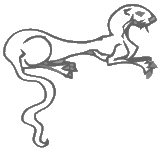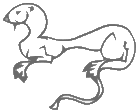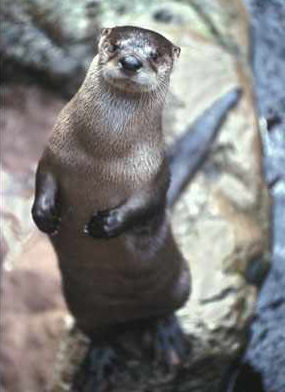 |
 |
 |
 |
 |
 |
 |
 |



North American River
Otter
Description: Size: From nose to tail, the North American River Otter is 100 to 153 cm long. The tail alone is 31-46 cm long.
Nose: Diamond shaped, the nostrils are in the lower 1/2 and outer 1/4 of the nose. Feet: The feet are very strong, with strong claws and webbing. Hair: Very thick and sleek. The guardhairs are 1.7 to 2 cm long, and the underhairs are 8 to 9 mm long. Track/Sign: North American river otters scent- and scat- mark their territory.
Ecology Habitat: North American River Otters den in banks of rivers, streams, or lakes. They can be found almost everywhere that there is water in North America, including coastal areas Range/Distribution: Found throughout most of North America, with the exception of a few states where they have not been reintroduced.
Conservation
Status: Least Concern
Behavior Life Cycle: North American River Otters breed in March and April. They experience delayed implantation of embryos, so although pregnancy lasts 10-12 months, gestation is actually only 60-63 days. The female will give birth to between 1 and 6 pups (generally 2-4) in late winter or early spring. Pups will open their eyes at about 4 weeks. They leave the holt for the first time at about 2 months, and start learning to swim and are weaned at about 4 months. The mother takes care of the pups entirely for their first six months, after which time the father will also help. Generally, young otters leave their mothers at about a year of age, around the time the next litter is born. They reach sexual maturity at the age of two. Social: North American River Otters are very social animals. They tend to travel in family groups consisting of a female and her pups, often joining another female who also has pups. North American River Otters do not tend to pair-bond (though sometimes they do), but males will help to raise the pups if given the opportunity. Females are very protective of their pups, and will often not let any other animals near them until they are about three months old. Though males tend to be more solitary than females, otters do not do well alone for long periods of time and will seek out the company of other otters. Individual: North American river otters are extremely playful, turning almost all regular activities into a game. They often create slides into the water in areas that they visit frequently. River otters have territories ranging from 5 to 48 miles of waterfront, depending on food and shelter availability, disturbance by humans, and other factors. Territory is about 7 for the average female. Males' territories are larger than females', and territories almost always overlap.
Similar species: The North American River Otter is sometimes confused with the Sea Otter ( in some areas along the Pacific coast), and sometimes in fresh water areas with other mammals that spend time in/near waterways such as nutria, muskrats, beaver, etc. Subspecies:
|
OtterQuest (c) 1999-current. Contact OtterQuest.
A few images on this web site have been borrowed from other sources, I credit them in the Links/Resource Page. Some may not yet be credited, if you know the source of an uncrdited photograph, please e-mail me with the information. Thank you. Dana


 Identification
Identification

